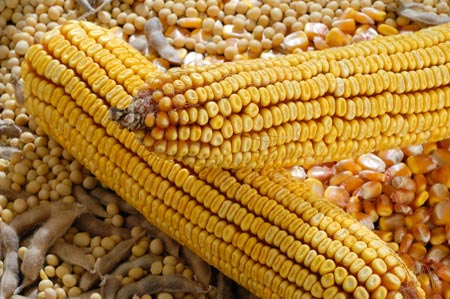 (Farm & Ranch Guide) – In early August, it appeared the U.S. and its global partners would produce enough soybeans.
(Farm & Ranch Guide) – In early August, it appeared the U.S. and its global partners would produce enough soybeans.
The July 29 Crop Progress report rated the 2013 soybean crop as 63 percent good to excellent compared with 29 percent for the same timeframe in 2012. Poor to very poor ratings were just 9 percent vs. 37 percent one year ago.
The next World Agricultural Supply & Demand Estimates report (WASDE) comes out on Aug. 12, and traders will study the numbers in that report.
At that same time, the USDA will share the results of resurveying soybean acres in 14 states in July. The information will be published in the Aug. 12 Crop Production report.
As of July 11, the USDA projected a U.S. soybean yield of 44.5 bushels per acre, and soybean production of 3.42 billion bushels. Ending stocks were pegged at a healthy 295 million bushels.
Global soybean production in that report was projected at 10.5 billion bushels.
The good news is that demand for soybeans will remain strong. The USDA, in their July WASDE report, estimated that China will import 2.535 billion bushels of 2013/14 soybeans, the European Union will import 444.6 million bushels, Japan – 101.4 million bushels and Mexico – 130.4 million bushels.
With a growing population and economy, China is rapidly increasing their fish and hog industries. Their land capacity to grow row crops is limited. They also import 96 percent of the soybeans they crush.
“The dynamics of world growth are pretty good. China is going to need the U.S. farmer every year,” said Ron McDaniel, trader and commodity analyst at the Minneapolis Grain Exchange.
On the CME Group exchange, soybean futures on Aug. 2 traded with September at $12.115, November at $11.80, January at $11.85, March at $11.88, and May 2014 at $11.89 per bushel. Compared with prices back on July 19, September was $1.175 lower, November was 95.5 cents lower, January was 96 cents lower, March was 92 cents lower and May was 91 cents lower.
McDaniel suggested that U.S. farmers are more likely to store their corn this fall, and sell their soybeans.
As of Aug. 2, the nearby futures market had a soybean-to-corn price ratio of 2.55 to 1. Historically, the ratio has been about 2.3 to 1, and McDaniel thinks even a ratio of 2.45 to 1 is pretty good.
“Early on, soybeans are still tighter than corn,” he said, adding the 2012 soybean carryout is projected at 125 million bushels.
“There is a bit of a guessing game going on. Will U.S. farmers sell their beans? Will Argentina (sell) their soybeans, because we’re going to need them in 30 days. Will we have rain delays? In the front end, the soybeans have volatility.”
In the July WASDE report, USDA forecast a season-average 2013/14 soybean price of $9.75-$11.75 per bushel.
At one elevator in western Minnesota followed in this column, cash soybeans were $12.32 with a basis of 50 cents over on Aug. 2. Compared with the cash quote on July 19, the price was $2.58 lower, but the basis had improved by 50 cents.
The new crop bid for October was $11.22 with a basis of minus 60 cents, which was in line with the USDA forecast in July.
Weather across the U.S. for the months of August and September is expected to have a significant role in soybean production and prices.




